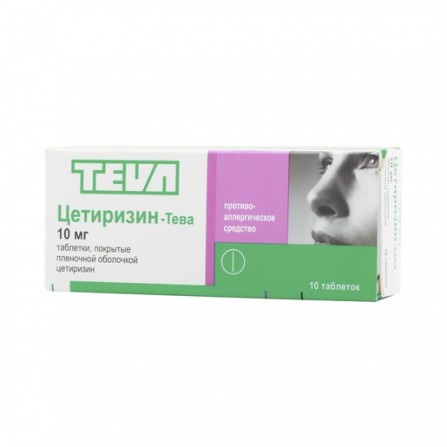Cetirizine Teva coated pills 10mg N10
Condition: New product
1000 Items
Rating:
Be the first to write a review!

More info
Active ingredients
Cetirizine
Release form
Pills
Composition
Cetirizine dihydrochloride 10 mg.; Excipients: microcrystalline cellulose 40 mg, lactose monohydrate 63.5 mg, colloidal silicon dioxide 0.5 mg, magnesium stearate 1 mg; Shell composition: OY-GM-28900 opadry white: hypromellose (E464) 0.94 mg, polydext; 0.94 mg, titanium dioxide (E171) 0.94 mg, macrogol-4000 0.18 mg.
Pharmacological effect
Blocking histamine H1-receptor III generation. Affects the "early" stage of an allergic reaction and reduces the migration of eosinophils; limits the release of mediators at the "late" stage of an allergic reaction. Practically no anticholinergic and antiserotonin action. In therapeutic doses does not cause sedation.
Pharmacokinetics
Rapidly absorbed from the gastrointestinal tract, Cmax after ingestion is achieved after 1 h. The bioavailability of cetirizine when taken in the form of pills and syrup is the same. Food does not affect the completeness of absorption (AUC), but it prolongs the time to reach Cmax by 1 h and reduces the value of Cmax by 23%. When taken in a dose of 10 mg 1 time / day for 10 days, Css in plasma is 310 ng / ml and is noted 0.5–1.5 h after administration. Plasma protein binding is 93% and does not change at cetirizine concentrations in the range of 25-1000 ng / ml. The pharmacokinetic parameters of cetirizine change linearly with its appointment in a dose of 5-60 mg. Vd - 0.5 l / kg. In small quantities, it is metabolized in the liver by O-dealkylation with the formation of a pharmacologically inactive metabolite (unlike other antagonists of H1-histamine receptors, which are metabolized in the liver using a cytochrome system). Does not accumulate. 2/3 of the dose is excreted unchanged by the kidneys and about 10% - with feces. Systemic clearance - 53 ml / min. T1 / 2 in adults - 7-10 hours, in children aged from 6 to 12 years old - 6 hours, from 2 to 6 years old - 5 hours, from 6 months to 2 years old - 3.1 hours. In elderly patients, T1 / 2 increased by 50%, and systemic clearance is reduced by 40% (reduced kidney function). In patients with impaired renal function (CK less than 40 ml / min), the clearance of the drug decreases and T1 / 2 is lengthened (for example, in patients on hemodialysis, the total clearance decreases by 70% and is 0.3 ml / min / kg, and it is extended by 3 times) that demands the corresponding change of the mode of dispensing. Practically not removed during hemodialysis. In patients with chronic liver diseases (hepatocellular,cholestatic or biliary cirrhosis) T1 / 2 lengthening is observed by 50% and total clearance is reduced by 40% (correction of the dosing regimen is required only with a concomitant decrease in the glomerular filtration rate). Penetrates into breast milk.
Indications
Hay fever; allergic rhinitis, conjunctivitis, dermatitis; urticaria, angioedema.
Contraindications
Renal failure, pregnancy, lactation, hypersensitivity to cetirizine.
Use during pregnancy and lactation
Contraindicated for use during pregnancy and lactation.
Dosage and administration
Adults and children over 12 years old - 10 mg / day in 1-2 doses. Children aged 2-6 years - 5 mg / day in 1-2 doses.; Patients with moderate or severe form of renal insufficiency, the dose should be reduced by 2 times.
Side effects
Possible: dry mouth, drowsiness, headache, fatigue.; Rarely: skin manifestations of allergic reactions, angioedema.; In some cases: dyspepsia, agitation.
Interaction with other drugs
Pharmacokinetic interactions with pseudoephedrine, cimetidine, ketoconazole, erythromycin, azithromycin, diazepam and glipiside were not detected. Joint appointment with teofillin (400 mg / day) resulted in a 16% decrease in total clearance of cetirizine (theophylline kinetics did not change).
special instructions
Cetirizine is prescribed with caution to patients with chronic renal failure (moderate and severe severity - a dosing regimen is required), elderly patients (possible reduction of glomerular filtration); Older patients with normal renal function do not need dose adjustment.; Pediatric use; cetirizine for children (experience of use in children under the age of 1 year is not enough); Effect on the ability to drive vehicles and control mechanisms; When a dose of 10 mg / day is exceeded, the ability to react quickly iam may get worse. During the period of treatment, it is necessary to refrain from engaging in potentially hazardous activities that require high concentration of attention and quickness of psychomotor reactions.




